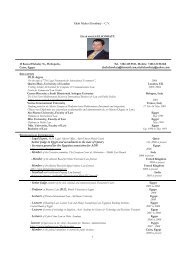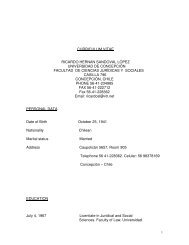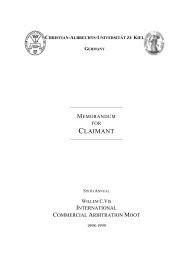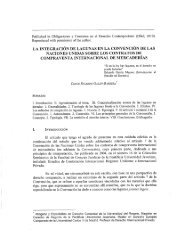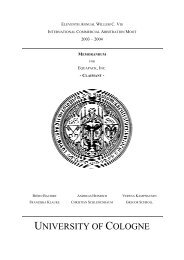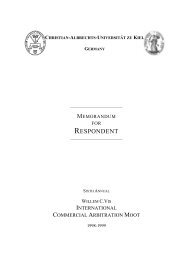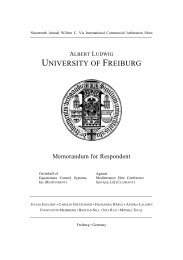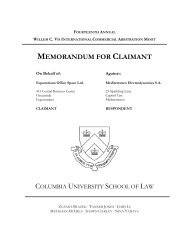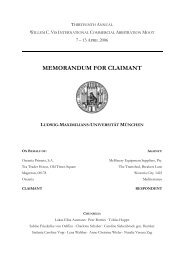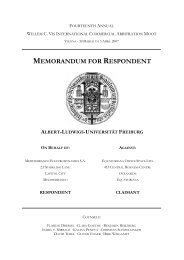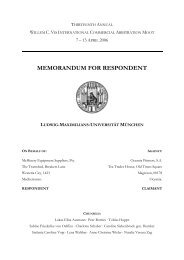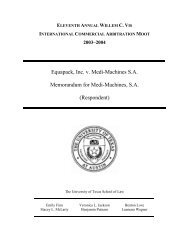MEMORANDUM FOR RESPONDENT - Pace University
MEMORANDUM FOR RESPONDENT - Pace University
MEMORANDUM FOR RESPONDENT - Pace University
You also want an ePaper? Increase the reach of your titles
YUMPU automatically turns print PDFs into web optimized ePapers that Google loves.
QUEEN’S UNIVERSITY FACULTY OF LAW<br />
into a “trial by press release” [Born 2282]. The Tribunal is entitled to take steps to protect the<br />
integrity of the arbitration [Biwater Gauff v. Tanzania 135], and should do so by issuing an<br />
injunctive order.<br />
49. The circumstances of the current dispute meet the conditions for granting an interim measure<br />
under art. 17A of the Model Law. First, harm “not adequately reparable by an award of damages<br />
is likely” if the Tribunal does not grant the desired relief; this does not conflict with an order for<br />
damages [A] Second, Respondent has a reasonable prospect of success on the claim’s merits [B].<br />
A. Damages are insufficient to protect against future breaches of confidentiality.<br />
50. The Tribunal should issue an injunctive order protecting confidentiality to preserve the status quo<br />
and prevent harm from future disclosures. The Tribunal is empowered by art. 17(2)(a) to issue<br />
measures preserving the status quo, including orders prohibiting public statements that breach<br />
confidentiality [Born 1999]. Article 17A(1)(a) Model Law stipulates that Respondent would have<br />
to show that harm not adequately reparable by damages would result if a protective measure was<br />
not ordered. Claimant may argue that it is contradictory for Respondent to ask for both an<br />
interim measure and damages, but that assertion mischaracterizes the remedies. The two<br />
remedies work together with respect to future breaches of confidentiality: a declaration that<br />
damages will ensue from future violations is a way of ensuring compliance with an injunctive<br />
order. An injunctive order protects Respondent against future disclosures in breach of the<br />
confidentiality obligation. Damages, on the other hand, redress past disclosures [Noussia 169].<br />
Hence, although each remedy relates to confidentiality, the two are not mutually exclusive.<br />
51. Damages are often considered to be an inadequate or unsatisfactory remedy for breaches of<br />
confidentiality. For this reason, it is “appropriate, and generally necessary, for tribunals to issue<br />
provisional measures ordering compliance with confidentiality obligations” [Born 2008;<br />
Cook/Garcia ft 121]. By definition, damages can only be sought after harm from a breach of<br />
confidentiality has already occurred [Hwang/Chung 640; Brown 1016]. An injunctive order, on the<br />
other hand, protects against future breaches of confidentiality.<br />
52. Respondent could suffer economic loss as a result of Claimant’s disclosures. In True North v.<br />
Bleustein, True North’s disclosure of the existence of the dispute and the arbitration proceedings<br />
resulted in negative economic consequences for the other party, specifically a drop in share value<br />
[(France 1999); Poudret/Besson 316]. The Commercial Court of Paris enjoined True North from<br />
making any further disclosures about the arbitration. Claimant’s past disclosure and any future<br />
disclosures may result in similar negative consequences for Respondent. The threat of negative<br />
publicity has been held to be sufficient basis to issue an injunctive order, so long as there is not a<br />
countervailing public interest in disclosure [Biwater Gauff v. Tanzania; Giovanna a Beccara v. Argentine<br />
16



